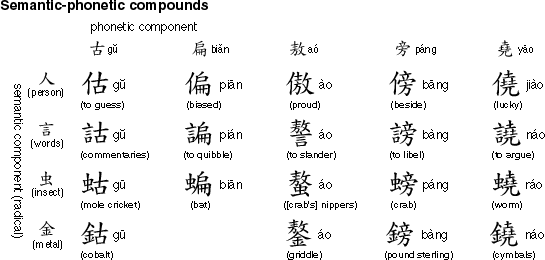Traditionally Chinese characters are divided into six categories (六書 liùshū "Six Writings"). This classification is often attributed to Xu Shen's second century dictionary Shuowen Jiezi, but it has been dated earlier. This page shows four of those categories.

Thought to be the oldest types of characters, pictographs were originally pictures of things. During the past 5,000 years or so they have become simplified and stylised.

Ideographs are graphical representations of abstract ideas.

Compound pictographs and ideographs combine one or more pictographs or ideographs to form new characters. Both component parts contribute to the meaning of the compound character.
The character for thought was originally a combination of the characters for brain + heart. In the modern character the brain component has been replaced by the character for field, which is very similar to the one for brain.

Semantic-phonetic compounds represent around 90% of all existing characters and consist of two parts: a semantic component or radical which hints at the meaning of the character, and a phonetic component which gives a clue to the pronunciation of the character.
Characters containing the same phonetic component may have the same sound and the same tone, the same sound but a different tone, the same initial or final sound, or a different sound and a different tone.
Phonetic components are generally a more reliable indication of pronunciation than semantic components are of meaning.
Further information about the Chinese script
Books about Chinese characters and calligraphy
Mandarin, Shanghainese, Hokkien, Taiwanese and
Cantonese
Written Chinese: Oracle Bone Script, Simplified characters, Bopomofo, Types of characters, Structure of written Chinese, Evolution of characters, How the Chinese script works, Xiao'erjing, General Chinese
Spoken Chinese: Mandarin, Dungan, Wu, Shanghainese, Wenzhounese, Yue, Cantonese, Weitou, Min, Jian'ou, Taiwanese, Teochew, Fuzhounese, Puxian, Hakka, Xiang, Gan, How many people speak Chinese?
Other Chinese pages: Chinese numbers (數碼) | Chinese classifiers (量詞) | Electronic dictionaries | Chinese links | Books: Chinese characters and calligraphy | Cantonese | Mandarin, Shanghainese, Hokkien and Taiwanese
Akkadian Cuneiform, Ancient Egyptian (Demotic), Ancient Egyptian (Hieratic), Ancient Egyptian (Hieroglyphs), Chinese, Chữ-nôm, Cuneiform, Japanese, Jurchen, Khitan, Linear B, Luwian, Mayan, Naxi, Sawndip (Old Zhuang), Sui, Sumerian Cuneiform, Tangut (Hsihsia)
Page last modified: 15.03.23
[top]
You can support this site by Buying Me A Coffee, and if you like what you see on this page, you can use the buttons below to share it with people you know.

If you like this site and find it useful, you can support it by making a donation via PayPal or Patreon, or by contributing in other ways. Omniglot is how I make my living.
Note: all links on this site to Amazon.com, Amazon.co.uk
and Amazon.fr
are affiliate links. This means I earn a commission if you click on any of them and buy something. So by clicking on these links you can help to support this site.
[top]